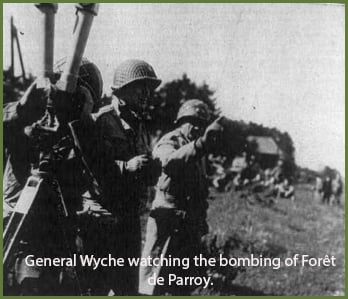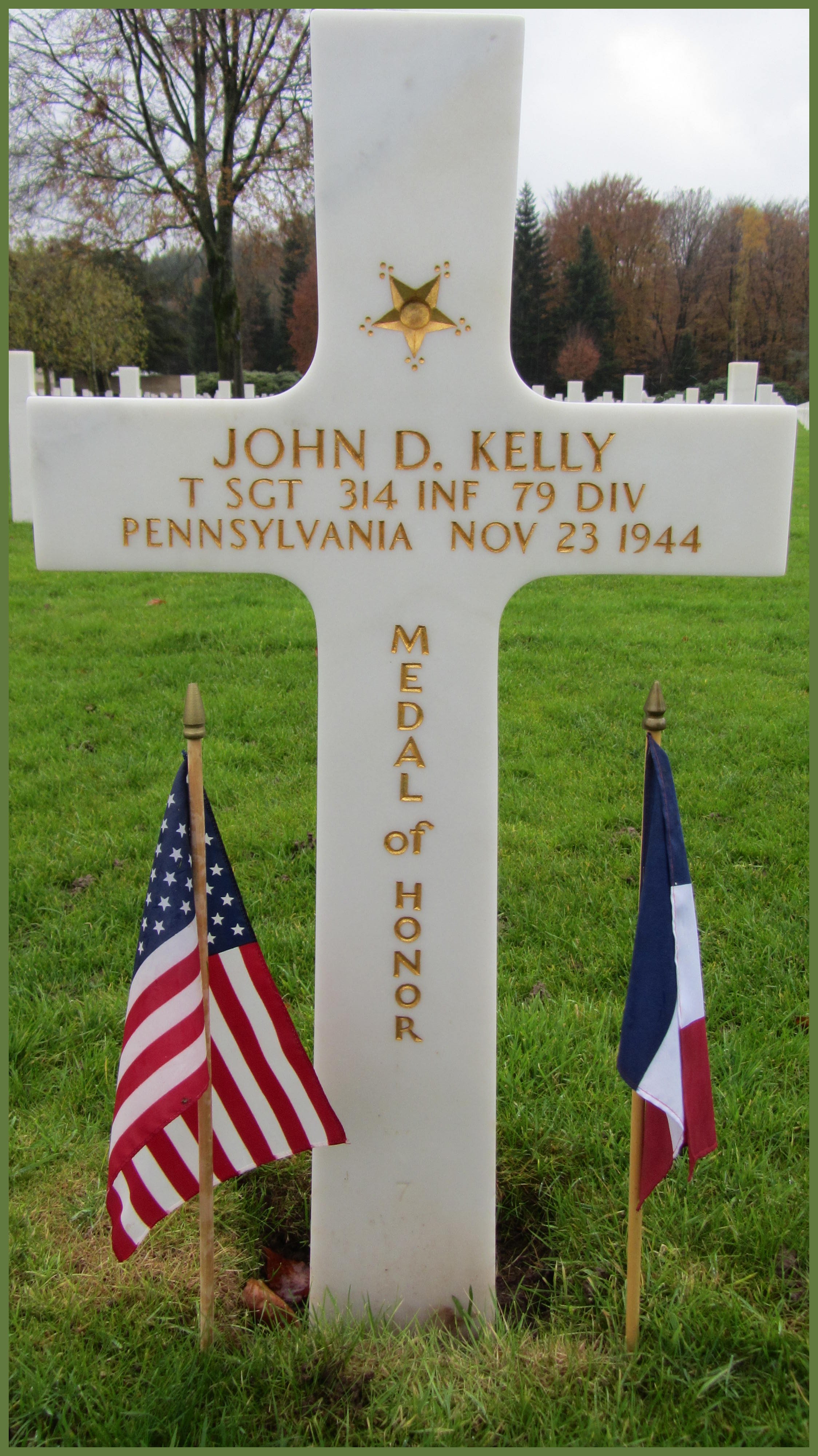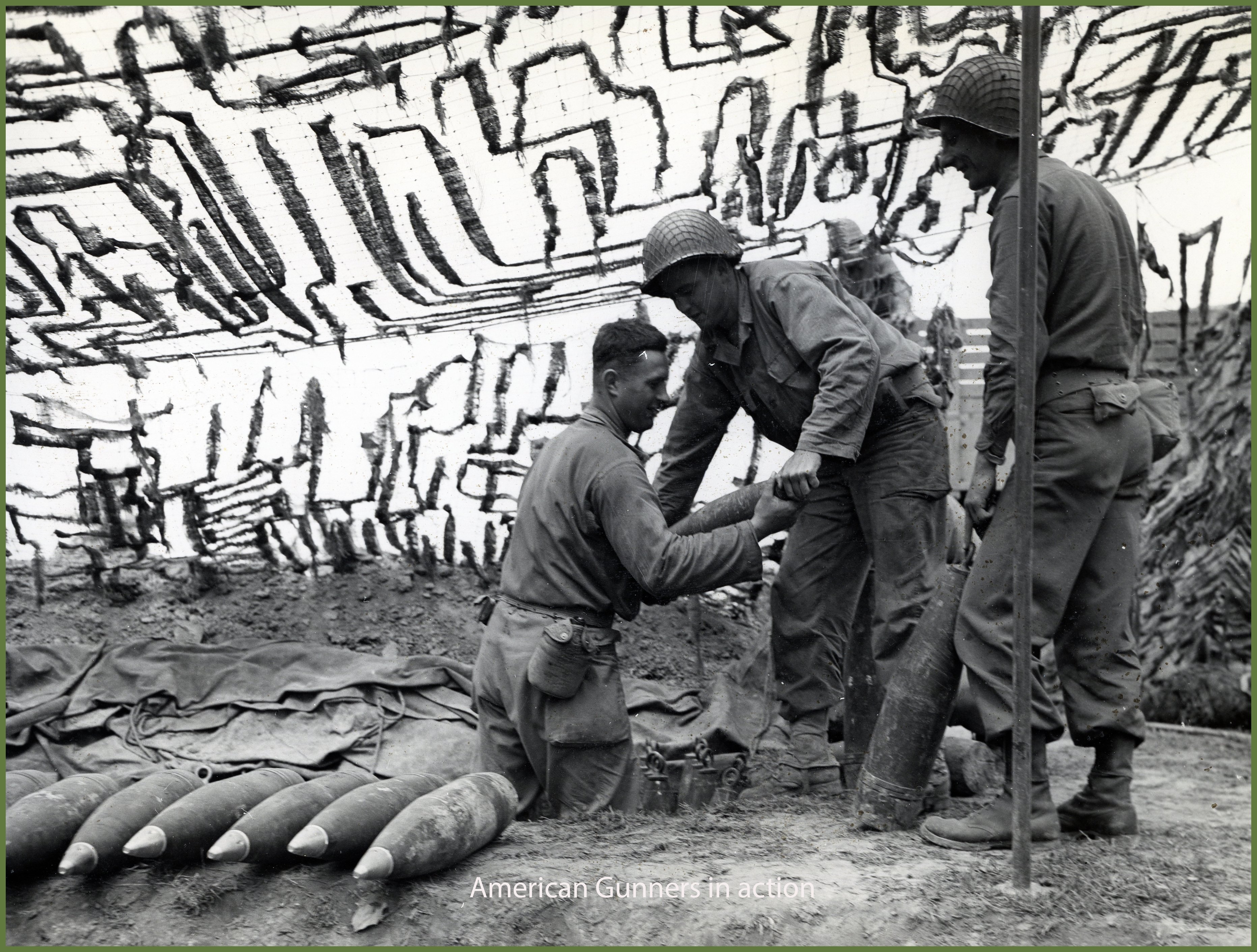Note: Some information may contradict each other regarding the actions performed by the battalions, or regarding the enemy forces. This is due to the ferocity of the fighting, some men testified to have seen halftracks, while others tanks.
After the end of what the U.S Army called the “Rat Race”, the German Army found shelter behind the Siegfried Line and in the famous Alsace, Lorraine counties. Those were not annexed by the 3rd Reich but became part of the Reich, it is for this reason Germans were determined to fight until the last. Hedgerows, orchards of Normandy and Mayenne counties have given way to the large pine forests and the red earth.
The 79th Infantry Division entered at this time in a new Campaign.
On the 21st of September, the 313th Infantry Regiment moved from Lunéville to Moncel-lès-Lunéville to crush the German Army which found cover inside Forêt de Parroy.
79th Infantry Division moving from Lunéville to Moncel-lès-Lunéville - © Footage CombatReels.com
1st Battalion of the 313th Infantry Regiment
The Battalion took defensive positions in Moncel-lès-Lunéville, “C” Company was inside the village, “B” Company on the road leading to Lunéville and “A” Company out posting the northwest tip of Forêt de Mondon. Six days later, the entire Battalion moved to a new Assembly Area at Chanteheux, to prepare the attack on Forêt de Parroy.
The attack was scheduled at 1300 hours on September 28th but men jumped at 1400 hours due to the delay of the bombing. The axis of advance was northeast with “B” Company attacking down the draw, West of the pine woods, “C” Company attacking through the wood while “A” Company was at the rear as support.
Shelling of the Forêt de Parroy - ©Footage CombatReels.com
Both attacking Companies met scattered small arms fire but when they hit the edge of the forest where the Sionviller-Croismare road cuts through the southwest corner, it was not the same story. Men ran into mortar fire, machine gun fire, and a tank position making impossible any movement.
It was impossible for Captain Hugh A. McGettigan to perfectly determine the number of tanks, one, maybe two? But it seemed that at least two were engaged firing from their dug-in emplacement.
It was getting dark, 1st Battalion suffered heavy casualties, men were helpless to do anything about the tanks, the only solution was to reform the line at the edge of the wood between the 3rd Battalion and the boundary of the 315th Infantry Regiment.
Note: Commanding Officer of the Battalion, Lieutenant-Colonel Joseph Novellino was relieved of his command then Executive Officer, Major Merritt H. Hursh took command.
The next day, the 29th of September, men continued their attack by reaching the position they had reached the previous day, and once again they were stopped at the crossroad by tanks fire and in addition 20mm antiaircraft fire. The decision to set up mortars was taken but it was impossible to know if any damage were done, on the other hand the antiaircraft guns mounted on halftracks caused serious damage.
When 1st Battalion tried to withdraw because of the heavy enemy fire, tanks fired on them and enemy infantrymen who were dug-in at the East of the road emerged from their holes then attacked. Captain Alven C. Hill, Commanding Officer of “C” Company was killed that day by machine gun fire.
The Battalion suffered a lot of casualties that day, approximately eighty. Either Killed, Wounded in Action or taken as prisoners. Men were afterwards withdrawn to be put in reserve while 3rd Battalion launched an attack to encircle the crossroad and cut the main East-West road behind them.
For the next two days, 1st Battalion stayed in reserve as it suffered heavy casualties on September 28th and 29th,1944.
It was apparent that the withdrawal of the 28th of September, was a rout, according to the 2nd and 3rd Battalions Officers. Lieutenant-Colonel Novellino was not only relieved of his command but was recommended by Colonel Sterling A. Wood for reclassification.
2nd Battalion of the 313th Infantry Regiment
On September 21st, 2nd Battalion of the 313th Infantry Regiment moved from Lunéville to join the 3rd Battalion in attacking Moncel-lès-Lunéville. Men crossed the Meurthe River by using footbridge without meeting any opposition, because their comrades of the 3rd silenced out the German positions. By 1730 hours the 2nd Battalion entered the village and occupied it for the night.
Occupied doesn’t mean liberated, during the early hours of the next day, one-hundred and fifty German Infantrymen supported by eight IV tanks launched a counterattack at the West, coming from Forêt de Mondon. The American resistance was so heavy that they destroyed four enemy tanks forcing the rest of the enemy force to withdraw and to find cover in the woods.
Note: One tank was destroyed by a bazooka, the second knocked out by a 57mm gun, third one by a tank destroyer and the last one was hit by everything men could use including antitank grenades.
During the afternoon, both Battalions continued their attack toward the wood with the will to clean out it off the enemy presence. 3rd Battalion entered it by the southeast along the axis of the road and the 2nd Battalion attacked by the left flank. Contrary to the 3rd, boys of the 2nd were stopped by heavy tank and machine gun fire coming from the northeast tip of the wood.
On the second day of the attack (23rd) it was discovered that Germans turned out the “Ferme de La Fourasse” into a strongpoint, nevertheless 2nd Battalion took it by making thirty-five German soldiers, prisoners of war.
Note: In the meantime, 3rd Battalion was also successful and pushed through Forêt de Mondon by reaching the Saint-Georges Farm where they made contact with the 314th Infantry Regiment.
It was decided then that 2nd and 3rd Battalions will hold the line running from Tranchée de Mondon to Saint-Georges Farm. Men remained on this position for five days, until the 28th of September as the bombing of Forêt de Parroy was postponed several times.
 ©Photo from the Combat Unit History of the 79th Infantry Division
©Photo from the Combat Unit History of the 79th Infantry Division
Following the bombing the entire 313th Infantry Regiment resumed the attack at 1330 hours, 1st Battalion was advancing on the road Chanteheux-Champel (D-108A) hitting the forest at the Sionviller-Croismare road (D-160) (Those roads form a triangle) and find itself under heavy enemy fire.
Men of the 314th Infantry Regiment receiving instructions for the attack in Forêt de Parroy - © Footage CombatReels.com
Note: This footage also shows Technical Sergeant John D. Kelly showing his Distinguished Service Cross for his action in Cherbourg while taking Fort du Roule on June 25th, 1944. His actions would be then upgraded to the Medal of Honor but regretfully, John would be recipient of the Highest Distinction of the United States for a soldier in combat posthumously on January 4th, 1945. He paid the ultimate sacrifice on November 23rd,1944, and rests at Epinal American Cemetery.

Major Clarence E. Gooding, Commanding Officer of the 2nd Battalion described this situation as follows: “1st Battalion got kicked around”. Indeed, Germans fortified the crossroad, in addition two halftracks mounting 20mm Flak guns were brought to defend the positions causing most of the damage.
Note: The rescue came on the next day by the 3rd Battalion which by swinging to the right found itself behind the enemy.
Once 1st Battalion was saved, 2nd Battalion passed through their positions at 1745 hours on September 29th, to deploy two companies abreast just short of the road to maintain contact with the other elements as follows:
- “E” Company took position on the right to be in contact with “I” Company of the 3rd Battalion,
- “G” Company was on the left in contact with the 3rd Battalion of the 315th Infantry Regiment.
It was necessary to maintain contact between Battalions in case the Germans would take the decision to launch another counterattack.
And they did it! At 2330 hours, coming from the forest, between the two Battalions eighty Infantrymen armed with rifles and light machine guns clustered around a Mark IV tank attacked.
Despite the moon, a light haze made vision uncertain and it was difficult to perfectly identify if the man in front of you was an enemy or a friend, which caused the sending of reinforcements impossible when the American lines were almost pierced.
“I” Company took the brunt of the initial assault reducing its force to an effective of forty men, “E” Company was reduced to nighty-one-hundred men. Both companies had to withdrawn.
“I” Company found cover in a ditch, but the tank harassed it with its machine gun. As for “E” Company, it withdrew at the West and this was made possible thanks to 1st Lieutenant George H. Dale who manoeuvred his men under heavy enemy fire by means of individual orders and kept them from breaking under the attack.
In the meantime, the 310th Field Artillery Battalion opened fire trying to destroy the enemy tank but failed as observation was impossible. The risk of friendly fire was too great.
Finally at 0300 hours the German tank was destroyed by a bazooka rocket and the attack came to an end. The fighting was extremely intense and so close that the tracks of the Mark IV were found riddled with 30mm bullets.
After its withdrawal “E” Company maintained its positions but as the enemy had infiltrated through the lines Battalion Headquarters had to abandon its Command Post. Fifteen Germans were found dead and three prisoners were taken.
During the early hours of the 30th of September, Germans shelled “E” Company positions using 105mm and 155mm guns, making forty-seven casualties. At 1150 hours the attack toward Forêt de Parroy was resumed and this advance was successful.
On October 1st, 2nd Battalion in lead deployed “F” and “G” Companies in skirmish as fightings took place within 100 yards of the road. Boys of “F” Company found an enemy position composed of five mortars, five machine guns and machine pistols forcing it to crawl through the underbrush. This position was silenced out by using hand grenades while some men fired from the hip, killing at least twenty enemies.
Note: During this attack “F” Company suffered ten casualties, two men were Killed and eight were Wounding in Action.
It was decided to withdraw “F” Company so the 310th Field Artillery Battalion could take over with their 105mm guns by firing one-hundred and twenty rounds ahead of the Regiment along the road as far as Hill 303 in preparation for the renewal of the attack.
Note: While 310th Field Artillery Battalion fired its rounds, 313th Field Artillery Battalion came in action by directly firing on Hill 303.

Artillery Battalions did a very good job, a machine gun position, a mortar position were destroyed, in addition it was found that they were responsible of the enemy disorganization. 200-300 scattered Germans were found on each side of the road. A lot of these scattered enemies were picked up by the 314th Infantry Regiment. Many of them anxious to surrender, all were demoralized by the artillery fire.
Once the Artillery fire over, 2nd Battalion continued its advance by meeting scattered Germans, then they met the 314th Infantry Regiment on their final objective which was “Carrefour des Cinq” at 15h45 hours (AAR Spelling).
During the assault on Forêt de Parroy, 2nd Battalion had only two M4 tanks with 75mm Howitzer guns which took part in “F” Company’s assault on October 1st. Their fire was directed by Staff Sergeant Frank S. Roseman who volunteered to sit on top of the turret of one and told the direction of the enemy positions to the tank commander. He also contributed to the success of the attack by staying in the turret, exposed to enemy fire while shouting orders to the men on the two side of the road. Unfortunately, he paid the ultimate sacrifice when a bullet got him. He was posthumously awarded of the Bronze Star by General I.T Wyche.
3rd Battalion of the 313th Infantry Regiment
3rd Battalion moved from Moncel-lès-Lunéville to its new assembly area at the Froide Fontaine Farm, closing at 1545 hours on September 28th. Contrary to the 1st and 2nd Battalions, during the first day of the attack toward Forêt de Parroy, no resistance was met. Men had the mission to secure the southwestern tip of the wood and their mission was accomplish before dark.
On the second day of the attack, the 29th, German artillery shelled the 3rd Battalion, 1st Lieutenant Roberts said: “It was the heaviest enemy artillery concentration I have ever experienced”. Guns were 105mm, two of them came in action but as their rate of fire was so rapid, (8 rounds a minute per gun) Officers thought two batteries were engaged.
It was decided to continue the attack nevertheless, by attacking across the open ground at the East, then to enter the wood at the West of Hill 275. The plan was to gain the main road by cutting off the South and West sections of the woods. The open ground was reached at dark without any casualty, but the mortars started to poor shells on the 3rd Battalion, in addition men could hear a tank coming down the road.
During the night of the counterattack, 1st Lieutenant Roberts believed that not one but two tanks came down the road as he could see at one time cross fire over his own position. 1st Lieutenant Myron H. Murley from “M” Company opened fire on one of the two tanks with his 50mm machine gun.
“I” Company stated that by firing with his machine gun, 1st Lieutenant Murley gave the position of this Company. 1st Lieutenant Roberts only replied: “I” Company withdrew, but during the withdrawal 50-60 men were wounded or killed.”
Then “I” Company held the right flank of the 3rd Battalion, “K” tied in with “E” Company of the 2nd Battalion.
The opposition 313th Infantry Regiment encountered from September 28th to October 1st, came from elements of the 2113th Panzer Grenadier of the 113th Panzer Brigade and the 104th Panzer Grenadier of the 15th Panzer Grenadier Division. According to the Officers they fought in Tunisia, Sicily and Italy which made them battle-hardened soldiers.
Observations:
According to the Officers the amount of casualties during those three days battle is due to many things:
- Lack of tank supports (1st Lieutenant Harold Roberts S-3 of the 3rd Battalion asked Headquarters for the support of the tanks ; Headquarters: "We can't get them up" ; 1st Lieutenant Roberts: "Why? Because of the mud?" ; 1st Lieutenant Roberts: This is what they said".)
- Battalions advanced in Skirmish formation was according to some men a mistake.
- The route of the 1st Battalion was a turning point and had had a terrible consequence on the morale of the men.
- American Infantryman is afraid of the woods.
- Germans in the forest were fine fighters, their artillery with far fearer guns and less ammunition did far more damage than American guns
Written by Pierre Fallet - Normandy American Heroes

















